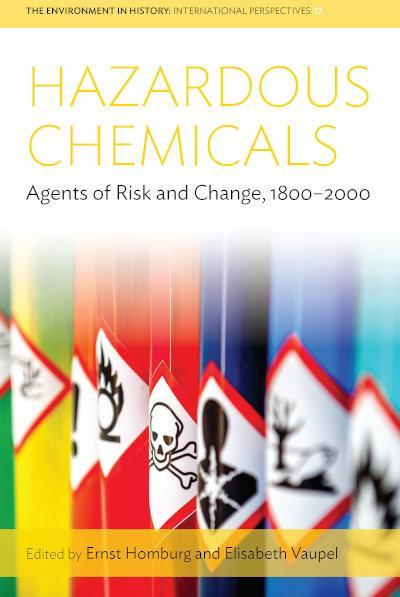Containing Contamination
Investigative journalists and environmental activists have sparked a growing public and political awareness of possible risks related to hazardous waste since the 1960s. A large number of politicians, businesses, and operators of waste management facilities in turn suggested that hazardous waste can be treated, contained, and finally disposed of without causing further harm—all thanks to the same technical ingenuity that led to its production in the first place. However, hazardous waste has proved over and over again to be more dangerously mobile, uncontainable, and mutable.

“DDT is good for me-e-e!” Color print magazine advertisement for Pennsalt DDT products. This ad appeared in Time Magazine, 30 July 1947.
“DDT is good for me-e-e!” Color print magazine advertisement for Pennsalt DDT products. This ad appeared in Time Magazine, 30 July 1947.
“DDT Is Good for Me-e-e!,” 30 July 1947.
Courtesy of Science History Institute. Philadelphia.
 This work is licensed under a Creative Commons Public Domain Mark 1.0 License.
This work is licensed under a Creative Commons Public Domain Mark 1.0 License.
Containing the uncontainable?

Emissions from a coal power plant in Datteln, Germany. Photograph by Arnold Paul, 2006.
Emissions from a coal power plant in Datteln, Germany. Photograph by Arnold Paul, 2006.
2006 Arnold Paul
Accessed via Wikimedia on 4 May 2021. Click here to view source.
 This work is licensed under a Creative Commons Attribution-ShareAlike 2.5 Generic License.
This work is licensed under a Creative Commons Attribution-ShareAlike 2.5 Generic License.
Engineers around the globe designed methods to neutralize the hazardous components of different types of waste and even recover energy and material resources before its final disposal. Incineration, chemical and biological treatment, as well as landfilling are common waste treatment techniques that have been increasingly refined over the decades. Waste incineration, for instance, as a practice that involves the combustion of organic material contained in hazardous waste, first emerged in the late nineteenth century. The technology then developed from simple “destructors,” as the first generation of incinerators were called, with essentially no pollution control, to more refined waste-to-energy plants (WTE) in the 1970s and 1980s, to today’s high-technology energy plants with flue gas control. Still, controlling hazardous waste has proven to be quite a challenge (with deadly implications) even under such controlled conditions. While the waste incinerators massively reduced the amounts of waste to be disposed through burning, they created new, even more toxic by-products: incinerator ash (both bottom and fly ash) and flue gases, the management of which needed new technological fixes. Also not all countries can afford the latest high-technology waste disposal facility, and incinerators without adequate filters will contribute to air pollution. Additionally, “burn pile” or “burn barrel” waste combustion technology is still common in many places around the globe, for instance at Agbogbloshie, one of the world’s largest e-waste scrap yards. To get to the valuable metals, waste workers melt off the plastic insulation of USB-cords and other items on a pile (burn pile) or in a barrel (burn barrel) all the while standing next to it, inhaling the toxic smoke.
Another all-too-common waste management strategy in the oil industry is to simply hope for the best. For instance, in the United States and beyond, oil companies re-inject liquid hazardous waste into underground rock formations with no or only minimal treatment. Paul Rosenfeld and Lydia Feng observed that “[o]ften times, hazardous waste is disposed of without prior treatment with the hope that the waste will eventually transmute into less hazardous wastes over time.” It might not come as a surprise that not all hazardous components have the generosity to simply disappear—or, as in the case of radioactive waste, it might take some millennia. Humanity has had the dire experience that there simply is no “ultimate sink” for hazardous waste, which eliminates and solves all problems of toxicity.

The decommissioned US Navy destroyer Towers slowly sinks in the Pacific Ocean after being used as a target hulk for live-fire sinking exercises (SINKEX) in 2002. The decommissioned ships are first made environmentally safe prior to towing and sinking in safe waters off prospective coastlines. In the past, the US Navy sank old ships loaded with outdated chemical weapons and hazardous waste in a similar way. Photograph by Andrew Betting, US Navy, 2002.
The decommissioned US Navy destroyer Towers slowly sinks in the Pacific Ocean after being used as a target hulk for live-fire sinking exercises (SINKEX) in 2002. The decommissioned ships are first made environmentally safe prior to towing and sinking in safe waters off prospective coastlines. In the past, the US Navy sank old ships loaded with outdated chemical weapons and hazardous waste in a similar way. Photograph by Andrew Betting, US Navy, 2002.
Courtesy of the US Navy.
Accessed via Wikimedia on 19 April 2021. Click here to view source.
 This work is licensed under a Creative Commons Public Domain Mark 1.0 License.
This work is licensed under a Creative Commons Public Domain Mark 1.0 License.
In contrast, dealing with hazardous waste is a dangerous and perpetual task. When containment fails, waste and its hazardous components start to disperse—they are flushed away by rain, taken up by animals and plants, and slowly migrate up the food chain. Through diffusion, human bodies themselves end up becoming sinks for the toxins emitted by modern society. Today, the typical European body contains about four hundred foreign chemicals, many of them with endocrine disrupting capacities. In 1970, that figure was 60. As Rob Nixon argues, pollution can be understood as a form of slow violence—toxic leaks and spills that affect human and more-than-human lives for generations to come. Human bodies and the spaces we inhabit can not be understood as individual, closed off, and protectable any more, but they are often rooted in highly relational, situated and contingent sets of practices.
Today, hazardous chemicals are spread all over the planet, which is often facilitated by a lack of waste containment practices during industrial manufacturing, marketing, and disposal processes. One thing is almost for sure: once the waste is produced, it won’t stay put where it was supposed to stay. Either the waste itself will be moved or its hazardous components take up the journey and contaminate air, soil, and water—in your backyard and in countries far away. In the twentieth century, dumping waste into surface waters became common because it was cheap and terrestrial jurisdictions did not apply in such spaces. Municipalities dumped sewage sludge, the Corps of Engineers dredge spoils, and industrial companies their production run-offs. In the 1960s and early 1970s, the US military made international headlines when conducting an operation to dump thousands of tons of unwanted munitions, including chemical weapons, off the Atlantic coast. Have a look at this virtual exhibition chapter by Hsuan Hsu on the deadly aftermath of outdated weapons. At around the same time, Dow Chemical company discharged wastewater containing alarming amounts of mercury in the Great Lakes area. Storage infrastructure continues to collapse and cause environmental catastrophes when its content starts to disperse—just think of the toxic mining sludge flushed down the Rio Doce in Brasil in 2015.

After a deadly mining dam collapse in Brazil in 2015, the Rio Doce swept millions of tons of toxic tailings into the Atlantic Ocean. NASA Earth Observatory image by Joshua Stevens, 2015.
After a deadly mining dam collapse in Brazil in 2015, the Rio Doce swept millions of tons of toxic tailings into the Atlantic Ocean. NASA Earth Observatory image by Joshua Stevens, 2015.
Courtesy of NASA.
Click here to view image source.
 This work is licensed under a Creative Commons Public Domain Mark 1.0 License.
This work is licensed under a Creative Commons Public Domain Mark 1.0 License.
Finally, many hazardous waste treatment facilities are planned following the probability principle, i.e. how likely an extreme weather situation such as an earthquake or tsunami might be and not the possibility principle, i.e. that is it possible at all. They are not made to withstand extreme situations that might become ever more prevalent due to the changing climate. In 2017, for instance, Hurricane Harvey unleashed the toxicants of more than 41 Superfund sites into the unprotected environment.
Contamination by hazardous waste comes in many forms. Only a few pollution events are as spectacular as a dam break. More often, health risks and problems rise slowly and only become visible with decades of delay. Proving the direct health impacts of hazardous waste management sites has been difficult, though residents in neighboring communities may exhibit medical conditions like cancer, respiratory diseases, or reduced birth weight of newborn babies, which have been linked to toxic environments. At times, private companies and government agencies took the deliberate decision to dump their unwanted hazardous waste on unsuspecting communities, often causing serious pollution in faraway places.
The original exhibition features an interactive gallery of book and video profiles from the Multimedia Library. View images of the items on the following pages.

Clapp, Jennifer. Toxic Exports: The Transfer of Hazardous Wastes from Rich to Poor Countries. Ithaca: Cornell University Press, 2001.
Read the introduction here.
© Cornell University Press. This work is used by permission of the copyright holder.

“In spite of decades of research on toxicants, along with the growing role of scientific expertise in public policy, problems surrounding contaminants and their effects on health have never appeared so important. This calls for a reconsideration of the roles of scientific knowledge and expertise in the definition and management of toxic issues, which this book seeks to do. It looks at public controversies, environmental and health crises, economic interests, and political responses, and demonstrates how and to what extent scientific knowledge about toxicants has been caught between scientific, economic, and political imperatives.” (Adapted from Berghahn Books)
© Berghahn Books. The copyright holder reserves, or holds for their own use, all the rights provided by copyright law, such as distribution, performance, and creation of derivative works.

“Although poisonous substances have been a hazard for the whole of human history, it is only with the development and large-scale production of new chemical substances over the last two centuries that toxic, manmade pollutants have become such a varied and widespread danger. Covering a host of both notorious and little-known chemicals, the chapters in this collection investigate the emergence of specific toxic, pathogenic, carcinogenic, and ecologically harmful chemicals as well as the scientific, cultural and legislative responses they have prompted. Each study situates chemical hazards in a long-term and transnational framework and demonstrates the importance of considering both the natural and the social contexts in which their histories have unfolded.” (Text from Berghahn Books)
© Berghahn Books. The copyright holder reserves, or holds for their own use, all the rights provided by copyright law, such as distribution, performance, and creation of derivative works.

Daniel, Pete. Toxic Drift: Pesticides and Health in the Post-World War II South. Baton Rouge: Louisiana State University Press, 2005.
© Louisiana State University Press. The copyright holder reserves, or holds for their own use, all the rights provided by copyright law, such as distribution, performance, and creation of derivative works.

Altemeier, Inge. Das Gift kommt zurück [The toxins return]. Hamburg: Altemeier & Hornung Filmproduktion, 2009. 45 min.
© 2009 Altemeier & Hornung Filmproduktion

Dill-Riaz, Shaheen. Eisenfresser [Ironeaters]. Hamburg: Lemme Film, 2007. HDV / 16mm, 85 min.
© 2007 Lemme Film.






Case study: The mysterious death of water buffalos in Egypt

Water buffaloes represented a valuable asset for rural households in Egypt. Unknown photographer, n.d.
Water buffaloes represented a valuable asset for rural households in Egypt. Unknown photographer, n.d.
Courtesy of Getty Research Institute, Los Angeles (2008.R.3).
Click here to view source.
 This work is licensed under a Creative Commons Public Domain Mark 1.0 License.
This work is licensed under a Creative Commons Public Domain Mark 1.0 License.
Over the course of 1971, Egypt was struck by a strange epidemic in water buffalos. At the time, the animals were key components of rural life in Egypt. Many families deemed their animal so valuable that they did not use it for fieldwork. When the animals fell ill in 1971, they first developed paralysis in their hindquarters. Then they would show difficulty breathing and trembling in the forelimbs. After roughly two months of suffering, the animals either had to be put down or died. Up to 1,300 water buffaloes succumbed to this strange illness, and many a family fortune vanished with the animal. Over the next three years, 65 Egyptian farmers also showed the same symptoms as the animals. Some of them died a similarly gruesome death.
In the beginning, farmers, medics, and officials were unsure about the causality of this mass dying of water buffaloes. Epidemiological investigation by the Egyptian government, finally, led to the suspicion that the agricultural use of a new pesticide had caused the epidemic. Previously, Egypt had bought the pesticide Leptophos from a company in the United States with loans from the United States Agency for International Development (US AID).

Detail of the graphic essay “Toxic Inheritance” that takes you on an intriguing visual journey to the polluted rainforests of Ecuador. Click the image to read the full essay.
Detail of the graphic essay “Toxic Inheritance” that takes you on an intriguing visual journey to the polluted rainforests of Ecuador. Click the image to read the full essay.
© 2021 Amelia Fiske and Jonas Fischer
Used by permission
The copyright holder reserves, or holds for their own use, all the rights provided by copyright law, such as distribution, performance, and creation of derivative works.
This transaction, however, was no ordinary business deal under the header of aid and development. US AID and the American company Velsicol kept secret that Leptophos was actually an unregistered chemical. The US Environmental Protection Agency had considered it to be too toxic and harmful for use in the United States. Yet, instead of disposing of the chemical at a hazardous waste site in the United States, the company sold Leptophos to more than 30 countries in the Global South. Egypt had little to no environmental and consumer protection legislation in place that could have helped avert the impact of this chemical.
How could this purposeful contamination happen? A major factor allowing for such hazardous material to be moved around the globe is its conceptual mutability: Almost up until today, there is no internationally binding definition of what constitutes hazardous waste beyond a philosophical definition. Instead of rigorous and strict common thresholds or waste management regulations, these definitions are formed through political, cultural, and socio-economic factors. But whatever you call or label them, the material properties of hazardous wastes remain and pose serious risks to human and animal lives. Many forms of pollution remain largely invisible. A combination of science, good storytelling, and the arts can make it visible. How, you might ask? Just check out the beautiful graphic essay Toxic Inheritance by Amelia Fiske and Jonas Fischer about oil contamination in the Ecuadorean rainforest.















